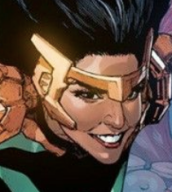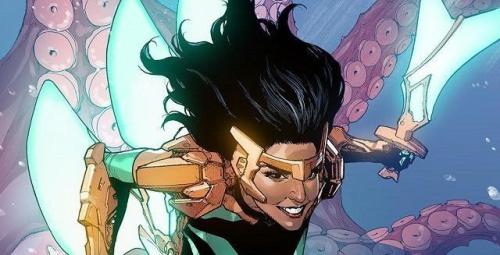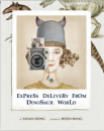I posted my first reaction a few days ago upon seeing the first look poster of the very first Filipina Superhero from Marvel. Since then, some discussion went down over on my Facebook Timeline. Somewhat heated debate between me and a white Facebook friend (not RL friend) trying to parse out our understanding of the data: that Tagalog is both a Language and a group of people; that people with Spanish heritages are less than 1% of the population; that the artist, although Filipino, displays largely western, marvel influenced comic book art styles, etc. I definitely outright challenged this white friend’s recollection and knowledge — and also pointed out that her 4-year living in the Philippines as a white person does not give her the same lived experiences as Filipina or Filipina Americans.
In the end, what matters here is not how this one white friend responded, but what my two Pinay educator friends had to say. In the spirit of being called in (since I’m not Pinay) and calling others in, I’m reposting their salient comments here. I’d really like to encourage Marvel and the creators of the new diverse superheroes to be courageous: this is uncharted water, but you have the resources to make large waves: do your due diligence and stay true to the cultures you’re representing even if they could be unfamiliar to western eyes. Create something fresh and unlike all the previous superhero stories! Don’t just do the same-old, same-old with merely changes of skin tones and costumes! (And please no resorting solely to “oriental mysticism”!)
Maria is an elementary school librarian who also produces and hosts a Theatre Review Show on YouTube to highlight work primarily by women and POC playwrights, actors, directors, etc. :
Maria Paz Alegre Hey all Pinay here. I’m Kampangan and Tagalog – though little known outside our country, Tagalog is indeed both a language and a people! Props to Roxanne for shining light on that little known fact. TBH my fam usually refer to ourselves as Manilenyos first, a nod to our capital city. I believe Tagalog can be compared to the word “English” – both a language and a people. The idea that we are strangers to our own land, coming from Spain and Polynesia to conquer is false. We’ve ALWAYS been there. Been there long before King Philip and long before Christ. Source: myself, and if experts are needed, my father Edilberto N.Alegre- an award winning scholar and PhD of Filipino Cultural Anthropology. His books are often required reading at the University of the Philippines where he taught for several decades, but feel free to google him if you like.
I’m also the one who made the spray tan comment. I stand by it and it appears I may need to explain.
I was ELATED AF to find out that Marvel made a Filipina superhero, only to feel a kick to my gut when I saw her. If you know my country, then you know all about the systemic bigotry derived directly from white colonialism. The bleaching cream, the rhinoplasty, the upper eyelid surgery, you name it… I cannot stress the havoc that this western standard of beauty has wrought on my people, especially on indigenous tribes like the Ati.
Are there mixed Filipinos with western features? Sure! But they often make up the “1%“ and are almost always the rich and elite. They do not look like the vast majority of my country people. My stepmother (Joycie Dorado Alegre) has been the Commissioner of the National Commission in Culture and the Arts to the Visayas and Mindanao and she personally worked on campaigns to encourage that “Black is Beautiful. Brown is Beautiful. You are Beautiful.” It’s been a very rewarding but very uphill battle.
So yes, to see the first representative of my race in Marvel with Eurocentric features? It sucks and it hurts.
Spain wins again. America wins again. The Filipinos must take a hit and live to fight another day, again. And while a Pinay character may be a step in the right direction to you, it greatly disappoints me and many others that she doesn’t look like like one. They could have done better.
Justine is a Health and Wellness educator whose Decolonizing Beauty Standards workshop at the People of Color Conference (for educators in Independent Schools) was the highlight for many attendees two years ago:
Justine AF Yo! Pinay here too and glad this convo is happening so thanks Roxanne Feldman for your allyship. I’m feeling like all I need to do though is clap and bow down because Maria Paz Alegre just crushed it with her eloquence. But since I rarely can keep quiet, I’ll add my 5 pesos here:
1. Yay that Marvel is naming a character an identity that matches one of mine.
2. Boo that she looks like the beauty ideal I’ve been told to emulate for most of my childhood. Unless Wave has that nose because her Tita was right about clothes-pinning it and she obeyed, she is the 1%
3. Interesting that the Cebuano artist drew a Pinay that had the more expensive body alterations done when they could’ve just drew the cheaper and more common one by applying Eskinol lotion to lighten herself up.
4. Decolonizing the beauty ideal is not dunking your face in Hawaiian Tropics oil. We’re more than a skin tone.
5. There better be some real Pilipinx words and cultural practices that aren’t all Spanish and American influenced in this screenplay to make up for this. Just saying.
P.S.
And a week later, our differences in opinions did not get reconciled. Instead of seeing what my Pinay friends expressed, that it would have been wonderful to see a more representational Pinay character, she posted this picture and claims that the woman on the right most “has basically the same shape face and brows of the comic character.”

Perhaps this the case of seeing what you want to see and refuse to see what you don’t want.


I alwo wonder why instead of seeing how most of these women do not look like the artist’s imagining of Wave, this Facebook friend decides to hone in on the one that, to her, makes the point.


 Over at
Over at  I haven’t posted for a long time — but I have been thinking about both our society and the children’s books that reflect (and hopefully help shape) our society and its future.
I haven’t posted for a long time — but I have been thinking about both our society and the children’s books that reflect (and hopefully help shape) our society and its future.




 This is a brief note to say that Emperor’s Riddle by Kat Zhang (Aladdin, May 2017) fits the bill of my continuing search for fun stories set in contemporary China that features Asian American children and authentically captures both the modern day life familiar to western readers and the cultural flavor unique to China. Definitely a book that I will introduce to the Chinese American mother and child who came seeking books featuring characters that “look more like her.”
This is a brief note to say that Emperor’s Riddle by Kat Zhang (Aladdin, May 2017) fits the bill of my continuing search for fun stories set in contemporary China that features Asian American children and authentically captures both the modern day life familiar to western readers and the cultural flavor unique to China. Definitely a book that I will introduce to the Chinese American mother and child who came seeking books featuring characters that “look more like her.”





















